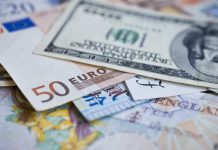After the pound climbed to a high of US$1.3319 early last week, it then dived following the Bank of England (BoE) monetary policy decision, hitting a low on Friday of US$1.3044 for the pound. The pound US dollar exchange rate hasn’t traded at this low level for sterling since early October.
| What do these figures mean? |
|---|
|
When measuring the value of a pair of currencies, one set equals 1 unit and the other shows the current equivalent. As the market moves, the amount will vary from minute to minute. For example, it could be written: 1 GBP = 1.28934 USD Here, £1 is equivalent to approximately $1.29. This specifically measures the pound’s worth against the dollar. If the US dollar amount increases in this pairing, it’s positive for the pound. Or, if you were looking at it the other way around: 1 USD = 0.77786 GBP In this example, $1 is equivalent to approximately £0.78. This measures the US dollar’s worth versus the British pound. If the sterling number gets larger, it’s good news for the dollar. |
Sterling tumbled at the end of last week despite the BoE raising interest rates. This is because the central bank failed to convince the markets that they would hike rates again soon. In fact, the odds of the next rate hike were pushed lower with investors predicting that the next hike could happen in September of next year. The reduction in chances of a rate hike pulled the pound lower.
| Why do raised interest rates usually boost a currency’s value? |
|---|
| Interest rates are key to understanding exchange rate movements. Those who have large sums of money to invest want the highest return on their investments. Higher interest rate environments tend to offer higher yields. So, if the interest rate, or at least the interest rate expectation, of a country is relatively higher compared to another, then it attracts more foreign capital investment. Large corporations and investors need local currency to invest. More local currency used then boosts the demand of that currency, pushing the value higher. |
This week the focus will switch back to Brexit. EU chief negotiator Michel Barnier and Brexit Secretary David Davis will kick off the next round of Brexit talks in Brussels. Pound traders are very aware that time is ticking and if meaningful progress is not made at the talks, the chances of the UK achieving a transition deal with the EU could fall away. This would be the worst-case scenario for the pound.
US Unemployment Falls to 4.1%, Investors Look to Trump’s Tour of Asia
The dollar could struggle in early trade on Monday as investors continue to deal with the US jobs report from Friday. The headline job creation figure failed to rebound as high as analysts had forecasted, which left the US weaker heading into the weekend. Although unemployment unexpectedly dropped from 4.2% to 4.1%, this was overshadowed by very disappointing average wage growth.
Investors and analysts are still confident about the US interest rate rise for December. However, with wages refusing to move significantly higher, the Federal Reserve could struggle to continue hiking interest rates next year. Already, some Fed members have expressed concern over wage growth and inflation levels and October’s poor reading could encourage more caution going forwards.
| How do employment figures affect the US dollar? |
|---|
| It works like this, when there is low unemployment and high job creation, the demand for workers increases. As demand for workers goes up, wages for those workers also go up. Which means the workers are now taking home more money to spend on cars, houses or in the shops. As a result, demand for goods and services also increase, pushing the prices of the good and services higher. That’s also known as inflation. When inflation moves higher, central banks are more likely to raise interest rates, which then pushes up the currency’s worth. |
Looking out across the week, there’s a relatively quiet US economic calendar in store. Instead, US President Trump’s Asia visit could come under closer scrutiny than usual. Trump intends to visit South Korea, which could upset North Korea and initiate another war of words or more bomb tests from the rogue nation. In previous flare ups at the end of summer between Trump and North Korea, the dollar has weakened, although the impact hasn’t ever lasted for long.
|
This article was initially published on TransferWise.com from the same author. The content at Currency Live is the sole opinion of the authors and in no way reflects the views of TransferWise Inc. |





